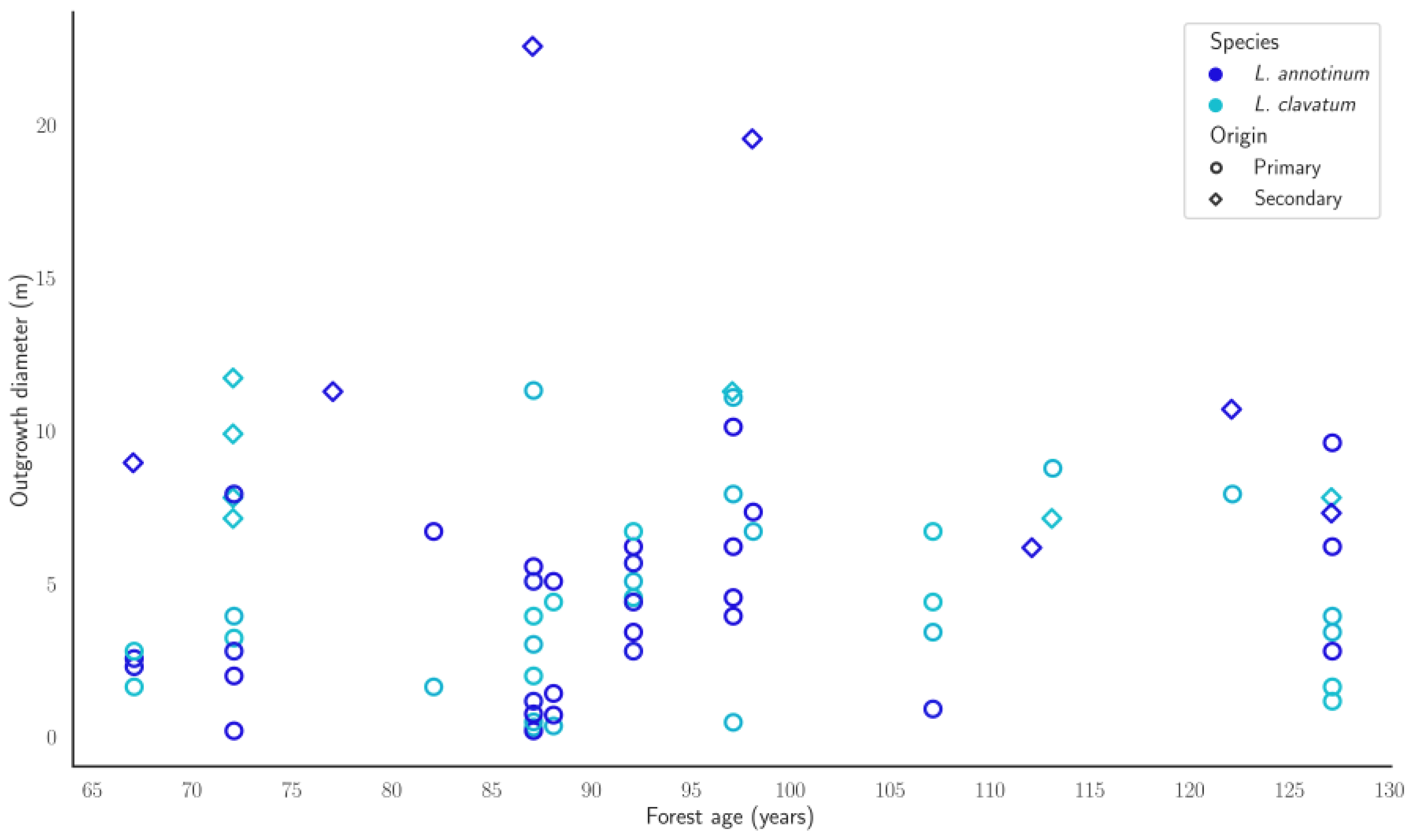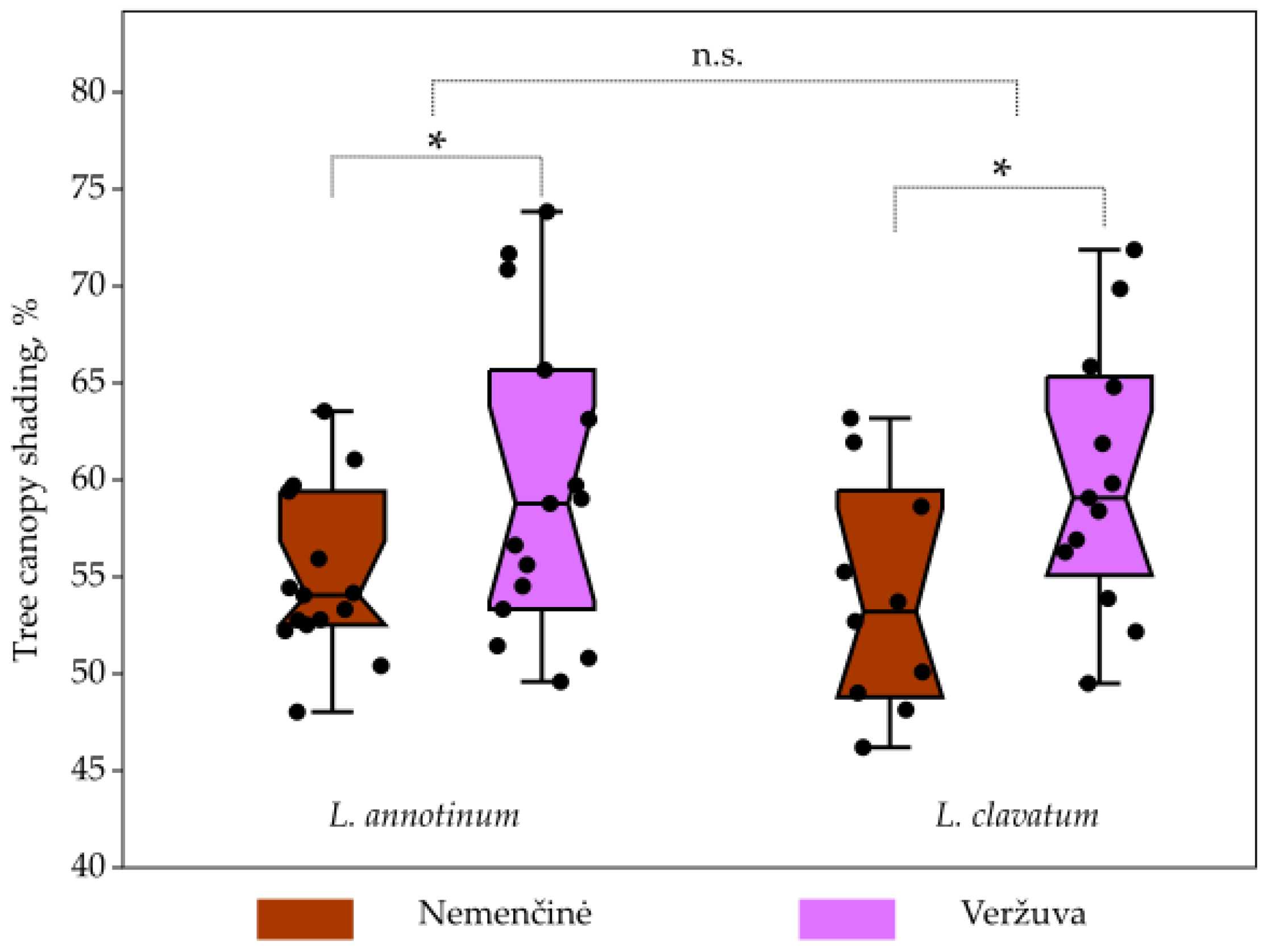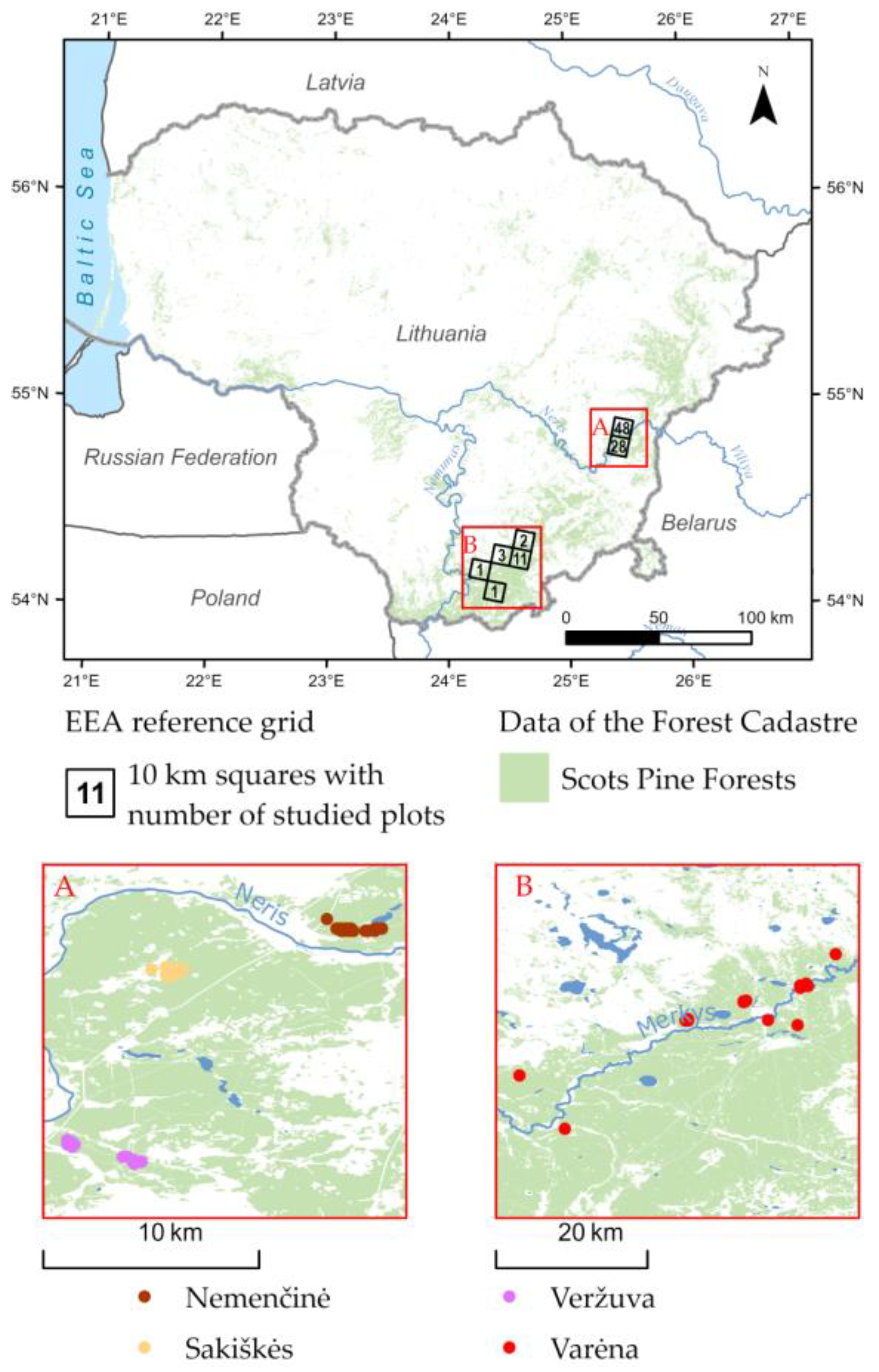Origin and Persistence of Lycopodium clavatum and Lycopodium annotinum (Lycopodiaceae) in Scots Pine Forests
Abstract
:1. Introduction
2. Results
3. Discussion
4. Materials and Methods
4.1. Study Area
4.2. Sampling Design
4.3. Statistical Analysis
4.4. DNA Analysis
Supplementary Materials
Author Contributions
Funding
Data Availability Statement
Conflicts of Interest
Appendix A
| Primer | Sequence 5′→3′ | Annealing Temperature, °C | Analyzed Bands | Polymorphism, % | DNA Band Length, bp | |||
|---|---|---|---|---|---|---|---|---|
| LA | LC | LA | LC | LA | LC | |||
| ISSR B | (AG)8CG | 51 | 6 | 7 | 50.00 | 57.14 | 700–1150 | 600–1250 |
| ISSR C | (AG)8TG | 49 | 10 | 7 | 50.00 | 57.14 | 620–1500 | 600–1500 |
| ISSR I-28 | (GT)6CG | 39 | 23 | 23 | 78.26 | 69.57 | 480–2000 | 580–2100 |
| ISSR I-39a | (AGC)4AC | 42 | 22 | 21 | 22.73 | 38.1 | 480–2100 | 580–2500 |
| ISSR I-50a | CCA(GCT)4 | 47 | 26 | 23 | 38.46 | 21.74 | 630–2700 | 460–3000 |
| WARD 2 | (AC)8G | 47 | 22 | 18 | 77.27 | 66.67 | 400–1800 | 580–2000 |
| ARCADE 3 | (CA)8TG | 49 | 22 | 22 | 45.45 | 27.27 | 400–2000 | 400–1700 |
| In total | 131 | 121 | ||||||
| Average | 51.74 ± 7.59 | 48.23 ± 7.23 | ||||||
| Measurement | Result, cm | Reference |
|---|---|---|
| Lycopodium annotinum L. | ||
| Total growth/year | 44.2 | Oinonen [19] |
| Growth up front/year | 22.1 | [19] |
| Average and range of rhizome growth/year | 32 (22–45) | [69] |
| Average number and range of aerial shoots/year | 7.9 (7–9) | [69] |
| Root growth/year | 0.7 | [70] |
| Length of horizontal module with 1 root | 9.2 | [70] |
| Mean annual extension/year | 6.3 | [71] |
| Mean annual extension/year | 20 | |
| Lycopodium clavatum L. | ||
| Total growth/year | 50.2 | [19] |
| Growth up front/year | 25.1 | [19] |
| Average and range of rhizome growth/year | 70 (48–103) | [69] |
| Average number and range of aerial shoots/year | 12.8 (12–14) | [69] |
| Measurement | 1985 | 1987 | 1989 | 1991 |
|---|---|---|---|---|
| Number of sprouts | 23 | 25 | 21 | 16 |
| New sprouts | - | 9 | 3 | - |
| Died off sprouts | - | 7 | 7 | 5 |
| Average length of horizontal modules, cm | 8 ± 1.5 | 12.5 ± 1.5 | 23.3 ± 2.5 | 33.7 ± 3.4 |
| Maximum length of horizontal modules, cm | 11 | 27 | 60 | 113 |
| Age Group | No. of Plots Evaluated | Overall Coverage, % |
|---|---|---|
| 26–35 | 13 | Up to 20 |
| 36–45 | 19 | Up to 20 |
| 46–55 | 15 | Up to 20 |
| 66–75 | 8 | Up to 20 |
| 76–85 | 20 | Up to 20 |
| 86–100 | 6 | 41–60 |
| 101–120 | 10 | Up to 20 |
| 121–140 | 4 | 61–80 |
| 141> | 5 | 41–60 |
References
- Eriksson, O. Dynamics of genets in clonal plants. Trends Ecol. Evol. 1993, 8, 313–316. [Google Scholar] [CrossRef] [PubMed]
- Honnay, O.; Bossuyt, B. Prolonged clonal growth: Escape route or route to extinction? Oikos 2005, 108, 427–432. [Google Scholar] [CrossRef]
- Grime, J.P. Plant Strategies and Vegetation Processes, 2nd ed.; John Wiley & Son: Chichester, UK, 2001; pp. 138–177. [Google Scholar]
- Eriksson, O. Seedling dynamics and life histories in clonal plants. Oikos 1989, 55, 231–238. [Google Scholar] [CrossRef]
- Callaghan, T.V.; Headley, A.D.; Svensson, B.M.; Lixian, L.; Lee, J.A.; Lindley, D.K. Modular growth and function in the vascular cryptogam Lycopodium annotinum. Proc. R. Soc. Lond. Ser. B 1986, 228, 195–206. [Google Scholar] [CrossRef]
- Wittig, R.; Jungman, R.; Ballach, H.J. The extent of clonality in large stands of Lycopodium annotinum L. Flora 2007, 202, 98–105. [Google Scholar] [CrossRef]
- Svensson, B.M.; Rydin, H.; Carlsson, B.A. Clonal plants in the community. In Vegetation Ecology, 2nd ed.; van der Maarel, E., Franklin, J., Eds.; Wiley-Blackwell: Oxford, UK, 2013; pp. 141–163. [Google Scholar]
- Bruchmann, H. Über die Prothallien und die Keimpflanzen mehrerer europäischer Lycopodien, und zwar über die von Lycopodium clavatum, L. annotinum, L. complanatum und L. selago; Perthes: Gotha, Germany, 1898. [Google Scholar]
- Pressel, S.; Bidartondo, M.I.; Field, K.J.; Rimington, W.R.; Duckett, J.G. Pteridophyte fungal associations: Current knowledge and future perspectives. J. Syst. Evol. 2016, 54, 666–678. [Google Scholar] [CrossRef]
- Perez-Lamarque, B.; Laurent-Webb, L.; Bourceret, A.; Maillet, L.; Bik, F.; Cartier, D.; Labolle, F.; Holveck, P.; Epp, D.; Selosse, M.A. Fungal microbiomes associated with Lycopodiaceae during ecological succession. Environ. Microbiol. Rep. 2023, 15, 109–118. [Google Scholar] [CrossRef]
- Headley, A.D.; Callaghan, T.V.; Lee, J.A. Water uptake and movement in the clonal plants, Lycopodium annotinum L. and Diphasiastrum complanatum (L.) Holub. New Phytol. 1988, 110, 497–502. [Google Scholar] [CrossRef]
- Newell, S.Y. Estimating fungal biomass and productivity in decomposing litter. In The Fungal Community: Its Organization and Role in the Ecosystem, 2nd ed.; Carroll, G.C., Wicklow, D.T., Eds.; Marcel Dekker: New York, NY, USA, 1992; pp. 521–561. [Google Scholar]
- Landa, K.; Benner, B.; Watson, M.A.; Gartner, J. Physiological integration for carbon in mayapple (Podophyllum peltatum), a clonal perennial herb. Oikos 1992, 63, 348–356. [Google Scholar] [CrossRef]
- Bainard, J.D.; Henry, T.A.; Bainard, L.D.; Newmaster, S.G. DNA content variation in monilophytes and lycophytes: Large genomes that are not endopolyploidy. Chromosome Res. 2011, 19, 763–775. [Google Scholar] [CrossRef]
- Marchant, D.B.; Chen, G.; Cai, S.; Chen, F.; Schafran, P.; Jenkins, J.; Shu, S.; Plott, C.; Webber, J.; Lovell, J.T.; et al. Dynamic genome evolution in a model fern. Nat. Plants 2022, 8, 1038–1051. [Google Scholar] [CrossRef]
- Eriksson, O. Evolution of seed dispersal and recruitment in clonal plants. Oikos 1992, 63, 439–448. [Google Scholar] [CrossRef]
- Rimgailė-Voicik, R.; Naujalis, J.R. Techniques for locating and analyzing subterranean Lycopodium and Diphasiastrum gametophytes in the field. Appl. Plant Sci. 2022, 10, e11458. [Google Scholar] [CrossRef] [PubMed]
- Rimgailė-Voicik, R.; Naujalis, J.R. Presence of juvenile club moss (Lycopodiaceae) sporophytes and gametophytes in relation to vegetation cover in dry pine forests. Am. Fern J. 2016, 106, 242–257. [Google Scholar] [CrossRef]
- Oinonen, E. Lycopodium clavatum L. ja L. annotinum L.-kasvustojen laajuus rinnastettuna samanpaikkaisiin L. complanatum L.-ja Pteridium aquilinum (L.) Kuhn—Esiintymiiin sekä puuston ikään j paloaikoihin. Acta For. Fenn. 1968, 87, 5–53. [Google Scholar]
- Watson, M.A.; Casper, B.B. Morphogenetic constraints on patterns of carbon distribution in plants. Annu. Rev. Ecol. Evol. Syst. 1984, 15, 233–258. [Google Scholar] [CrossRef]
- Yang, X.; Poelmans, W.; Grones, C.; Lakehal, A.; Pevernagie, J.; Van Bel, M.; Njo, M.; Xu, L.; Nelissen, H.; De Rybel, B.; et al. Spatial transcriptomics of a lycophyte root sheds light on root evolution. Curr. Biol. 2023, 33, 4069–4084. [Google Scholar] [CrossRef]
- Hetherington, A.J.; Dolan, L. The evolution of lycopsid rooting structures: Conservatism and disparity. New Phytol. 2017, 215, 538–544. [Google Scholar] [CrossRef]
- Sutherland, W.J.; Stillman, R.A. The foraging tactics of plants. Oikos 1988, 52, 239–244. [Google Scholar] [CrossRef]
- Horn, K.; Franke, T.; Unterseher, M.; Schnittler, M.; Beenken, L. Morphological and molecular analyses of fungal endophytes of achlorophyllous gametophytes of Diphasiastrum alpinum (Lycopodiaceae). Am. J. Bot. 2013, 11, 2158–2174. [Google Scholar] [CrossRef]
- Eames, A.J. Illustrations of some Lycopodium gametophytes. Am. Fern J. 1942, 32, 1–12. [Google Scholar] [CrossRef]
- Chytrý, M.; Tichý, L.; Hennekens, S.M.; Knollová, I.; Janssen, J.A.M.; Rodwell, J.S.; Peterka, T.; Marceno, C.; Landucci, F.; Danihelka, J.; et al. EUNIS Habitat Classification: Expert system, characteristic species combinations and distribution maps of European habitats. Appl. Veg. Sci. 2020, 23, 648–675. [Google Scholar] [CrossRef]
- European Council. Council Directive 92/43/EEC of 21 May 1992 on the conservation of natural habitats and of wild fauna and flora. Off. J. Eur. Union 1992, 206, 50. [Google Scholar]
- IUCN. Lycopodium annotinum. 2017. Available online: https://www.iucnredlist.org/species/18821015/85433421#assessment-information (accessed on 6 June 2024).
- Commission Regulation (EC) No 318/2008 of 31 March 2008, Amending Council Regulation (EC) No 338/97 on the Protection of Species of Wild Fauna and Flora by Regulating Trade Therein. Available online: https://eur-lex.europa.eu/LexUriServ/LexUriServ.do?uri=OJ:L:2008:095:0003:0062:EN:PDF (accessed on 6 June 2024).
- Braun-Blanquet, J. Pflanzensoziologie: Grundzüge der Vegetationskunde; Springer: Berlin/Heidelber, Germany, 1928. [Google Scholar]
- Ellenberg, H. Zeigerwerte der Gefaesspflanzen Mitteleuropas. Scripta Geobotanica IX; Verlag Erich Goltz: Göttingen, Germany, 1974. [Google Scholar]
- Tichý, L.; Axmanová, T.; Dengler, J.; Guarino, R.; Jansen, F.; Midolo, G.; Nobis, M.P.; Van Meerbeek, K.; Acic, S.; Attore, F.; et al. Ellenberg-type indicator values for European vascular plant species. J. Veg. Sci. 2023, 34, e13168. [Google Scholar] [CrossRef]
- Pec, G.J.; Karst, J.; Sywenky, A.N.; Cigan, P.W.; Erbilgin, N.; Simard, S.W.; Cahill, J.F., Jr. Rapid Increases in Forest Understory Diversity and Productivity following a Mountain Pine Beetle (Dendroctonus ponderosae) Outbreak in Pine Forests. PLoS ONE 2015, 10, e0124691. [Google Scholar] [CrossRef] [PubMed]
- Gilliam, F.S. The ecological significance of the herbaceous layer in temperate forest ecosystems. BioScience 2007, 57, 845–858. [Google Scholar] [CrossRef]
- Cherubini, P.; Battipaglia, G.; Innes, J.L. Tree vitality and forest health: Can tree-ring stable isotopes be used as indicators? Curr. For. Rep. 2021, 7, 69–80. [Google Scholar] [CrossRef]
- Hooper, D.U.; Adair, E.C.; Cardinale, B.J.; Byrnes, J.E.K.; Hungate, B.A.; Matulich, K.L.; Gonzalez, A.; Duffy, J.E.; Gamfeldt, L.; O’Connoret, M.I. A global synthesis reveals biodiversity loss as a major driver of ecosystem change. Nature 2012, 486, 105–108. [Google Scholar] [CrossRef] [PubMed]
- Lithuanian Forest Cutting Rules. Available online: https://e-seimas.lrs.lt/portal/legalAct/lt/TAD/TAIS.364764/asr (accessed on 6 June 2024).
- Naujalis, J.R. Sporiniai Induočiai Kaip Augalų Bendrijų Komponentai; Baltic ECO: Vilnius, Lithuania, 1995; p. 295. [Google Scholar]
- Oinonen, E. The time table of vegetative spreading in oak fern (Carpogymnia dryopteris (L.) Löve & Löve) and may-lily (Maianthemum bifolium (L.) F. W. Schmidt in Southern Finland. Acta For. Fenn. 1971, 118, 4–37. [Google Scholar]
- Oinonen, E. Keltalieon (Lycopodium complanatum L.) itiöllinen uudistuminen Etelä-Suomessa kloonien laajuutta ja ikää koskevan tutkimuksen valossa. Acta For. Fenn. 1967, 83, 3–85. [Google Scholar] [CrossRef]
- Nemchinova, A.V.; Krinycyn, I.G.; Smirnova, L.A. Biometricheskye osobennosti biomorf plauna bulavovidnovo (Lycopodium clavatum L.) v ontogeneze. Vestnik KGU Im. N. A. Nekrasova 2014, 4, 45–48. [Google Scholar]
- Svensson, B.M.; Floderus, B.; Callaghan, T.V. Lycopodium annotinum and light quality: Growth responses under canopies of two Vaccinium species. Folia Geobot. 1994, 29, 159–166. [Google Scholar] [CrossRef]
- Moola, F.M.; Vasseur, L. Recovery of late-seral vascular plants in a chronosequence of post-clearcut forest stands in coastal Nova Scotia, Canada. Plant Ecol. 2004, 172, 183–197. [Google Scholar] [CrossRef]
- Harper, J.L. Population Biology of Plants; Academic Press: London, UK, 1977; p. 892. [Google Scholar]
- Levin, D.A.; Crepet, W.L. Genetic variation in Lycopodium lucidulum: A phylogenetic relic. Evolution 1973, 27, 622–632. [Google Scholar] [PubMed]
- Ellstrand, N.C.; Roose, M.L. Patterns of Genotypic Diversity in Clonal Plant Species. Am. J. Bot. 1987, 74, 123–131. [Google Scholar] [CrossRef]
- Reisch, C.; Poschlod, P. Clonal diversity and subpopulation structure in central European relict populations of Saxifraga paniculata Mill. (Saxifragaceae). Feddes Repert. 2004, 115, 239–247. [Google Scholar] [CrossRef]
- Ranker, T.A.; Geiger, J.M.O. Population genetics. In Biology and Evolution of Ferns and Lycophytes; Ranker, T.A., Haufler, C.H., Eds.; Cambridge University Press: Cambridge, UK, 2008; pp. 75–103. [Google Scholar]
- Schnittler, M.; Horn, K.; Kaufmann, R.; Rimgailė-Voicik, R.; Klahr, A.; Bog, M.; Fuchs, J.; Bennert, H.W. Genetic diversity and hybrid formation in Central European club-mosses (Diphasiastrum, Lycopodiaceae)—New insights from cp microsatellites, two nuclear markers and AFLP. Mol. Phylogenet. Evol. 2019, 131, 181–192. [Google Scholar] [CrossRef] [PubMed]
- Shorohova, E.; Kneeshaw, D.; Kuuluvainen, T.; Gauthier, S. Variability and dynamics of old-growth forests in the circumboreal zone: Implications for conservation, restoration and management. Silva Fenn. 2011, 45, 785–806. [Google Scholar] [CrossRef]
- State Forest Service. Forest Statistic. 2021. Available online: https://amvmt.lrv.lt/lt/atviri-duomenys-1/misku-statistikos-leidiniai/misku-ukio-statistika/2021-m-1 (accessed on 6 June 2024).
- Marozas, V.; Sasnauskienė, J. Changes of ground vegetation after shelter wood cuttings in pine forests, the hemiboreal zone, Lithuania. Balt. For. 2021, 27, 72–79. [Google Scholar] [CrossRef]
- Herben, T.; Chytrý, M.; Klimešová, J. A quest for species-level indicator values for disturbance. J. Veg. Sci. 2016, 27, 628–636. [Google Scholar] [CrossRef]
- Sokołowski, A.W.; Paluch, R. The effect of clear cutting and artificial regeneration with pine on species composition of fresh coniferous stands in the Białowieża Primeval Forest. Sylwan 2006, 150, 12–19. [Google Scholar]
- Obidziński, A. Disturbance as an element of forest dynamics. Sylwan 2001, 145, 51–59. [Google Scholar]
- Karazija, S. Age related dynamics of pine forest communities in Lithuania. Balt. For. 2003, 9, 50–62. [Google Scholar]
- Jogiste, K.; Frelich, L.E.; Laarmann, D.; Vodde, F.; Baders, E.; Donis, J.; Jansons, A.; Kangur, A.; Korjus, H.; Koster, K.; et al. Imprints of management history on hemiboreal forest ecosystems in the Baltic States. Ecosphere 2018, 9, e02503. [Google Scholar] [CrossRef]
- National Land Service under the Ministry of Agriculture of the Republic of Lithuania. Lithuanian National Atlas; Ministry of Agriculture of the Republic of Lithuania: Vilnius, Lithuania, 2016; Volume 1.
- State Forest Service under the Lithuanian Ministry of Environment. Forest Cadastre Data. 2023. Available online: https://www.geoportal.lt/map#portalAction=openService&serviceUrl=https%3A%2F%2Fwww.geoportal.lt%2Fmapproxy%2Fvmt_mkd%2FmapServer (accessed on 5 May 2024).
- Nobis, M.; Hunziker, U. Automatic thresholding for hemispherical canopy photographs based on edge detection. Agric. For. Meteorol. 2005, 128, 243–250. [Google Scholar] [CrossRef]
- Frazer, G.W.; Canham, C.D.; Lertzman, K.P. Gap Light Analyzer (GLA): Imaging Software to Extract Canopy Structure and Gap Light Transmission Indices from True-Colour Fish Eye Photographs; User’s Manual and Program Documentation; Simon Fraser University: Burnaby, BC, Canada; Institute of Ecosystem Studies: Millbrook, NY, USA, 1999; Available online: https://rem-main.rem.sfu.ca/downloads/Forestry/GLAV2UsersManual.pdf (accessed on 6 June 2024).
- Kembel, S.W.; Cowan, P.D.; Helmus, M.R.; Cornwell, W.K. Picante: R tools for integrating phylogenies and ecology. Bioinformatics 2010, 11, 1463–1464. [Google Scholar] [CrossRef] [PubMed]
- Nei, M. Estimation of average heterozigosity and genetic distance from a small number of individuals. Genetics 1978, 89, 583–590. [Google Scholar] [CrossRef] [PubMed]
- Peakall, R.; Smouse, P. GenAlEx v.6: Genetic analysis in Excel. Population genetic software for teaching and research—An update. Bioinformatics 2006, 78, 265–285. [Google Scholar] [CrossRef] [PubMed]
- McKinney, W. Data Structures for Statistical Computing in Python. In Proceedings of the 9th Python in Science Conference, Austin, TX, USA, 28 June–3 July 2010. [Google Scholar]
- Vallat, R. Pingouin: Statistics in Python. J. Open Source Softw. 2018, 3, 1026. [Google Scholar] [CrossRef]
- Doyle, J.J.; Doyle, J.L. Isolation of plant DNA from fresh tissue. Focus 1990, 12, 13–15. [Google Scholar]
- Patamsytė, J.; Čėsnienė, T.; Naugžemys, D.; Kleizaitė, V.; Vaitkūnienė, V.; Rančelis, V.; Žvingila, D. Genetic diversity of warty cabbage (Bunias orientalis L.) revealed by RAPD and ISSR markers. Zemdirbyste 1990, 98, 29–300. [Google Scholar]
- Primack, R.B. Growth patterns of five species of Lycopodium. Am. Fern J. 1973, 63, 3–7. [Google Scholar] [CrossRef]
- Callaghan, T.V.; Svensson, B.M.; Headley, A.D. Modular growth of Lycopodium annotinum. Fern Gaz. 1986, 13, 65–76. [Google Scholar]
- Svensson, B.M. Studies of the Metapopulation Dynamics of Lycopodium annotinum and Its Microenvironment. Ph.D. Thesis, University of Lund, Lund, Sweden, 1987. [Google Scholar]





| Measurement, m2 | Result |
|---|---|
| Lycopodium annotinum L. (n = 30) | |
| Average vegetative shoot cover | 23.9 ± 11.4% |
| Min vegetative shoot cover | 5% |
| Max vegetative shoot cover | 50% |
| Average dried-out shoot cover | 10.1 ± 8.3% |
| Average number of strobili | 10.9 ± 10.3 |
| Total maximum number of strobili | 2218 |
| Lycopodium clavatum L. (n = 23) | |
| Average vegetative shoot cover | 17.9 ± 11.3% |
| Min vegetative shoot cover | 6% |
| Max vegetative shoot cover | 50% |
| Average dried-out shoot cover | 10% |
| Average number of strobili | 7 ± 7.1 |
| Total maximum number of strobili | 1077 |
Disclaimer/Publisher’s Note: The statements, opinions and data contained in all publications are solely those of the individual author(s) and contributor(s) and not of MDPI and/or the editor(s). MDPI and/or the editor(s) disclaim responsibility for any injury to people or property resulting from any ideas, methods, instructions or products referred to in the content. |
© 2024 by the authors. Licensee MDPI, Basel, Switzerland. This article is an open access article distributed under the terms and conditions of the Creative Commons Attribution (CC BY) license (https://creativecommons.org/licenses/by/4.0/).
Share and Cite
Rimgailė-Voicik, R.; Voicikas, A.; Fediajevaitė, J.; Juzėnas, S.; Patamsytė, J. Origin and Persistence of Lycopodium clavatum and Lycopodium annotinum (Lycopodiaceae) in Scots Pine Forests. Plants 2024, 13, 2120. https://doi.org/10.3390/plants13152120
Rimgailė-Voicik R, Voicikas A, Fediajevaitė J, Juzėnas S, Patamsytė J. Origin and Persistence of Lycopodium clavatum and Lycopodium annotinum (Lycopodiaceae) in Scots Pine Forests. Plants. 2024; 13(15):2120. https://doi.org/10.3390/plants13152120
Chicago/Turabian StyleRimgailė-Voicik, Radvilė, Aleksandras Voicikas, Julija Fediajevaitė, Sigitas Juzėnas, and Jolanta Patamsytė. 2024. "Origin and Persistence of Lycopodium clavatum and Lycopodium annotinum (Lycopodiaceae) in Scots Pine Forests" Plants 13, no. 15: 2120. https://doi.org/10.3390/plants13152120






